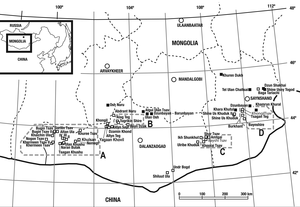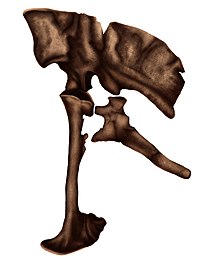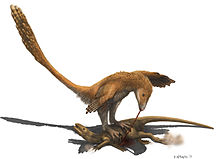Achillobator
| Achillobator | |
|---|---|

| |
| Skeletal diagram showing the size and preserved elements from holotype | |
| Scientific classification | |
| Domain: | Eukaryota |
| Kingdom: | Animalia |
| Phylum: | Chordata |
| Clade: | Dinosauria |
| Clade: | Saurischia |
| Clade: | Theropoda |
| Family: | †Dromaeosauridae |
| Clade: | †Eudromaeosauria |
| Subfamily: | †Dromaeosaurinae |
| Genus: | †Achillobator Perle et al. 1999 |
| Type species | |
| †Achillobator giganticus Perle et al. 1999
| |
Achillobator (
It was a large, heavily-built, ground-dwelling,
Achillobator is classified as a dromaeosaurid taxon, more specifically within Eudromaeosauria, a group of hypercarnivorous dromaeosaurids that were mainly terrestrial instead of arboreal or amphibious. In most cladistic analyses, Achillobator is recovered as a close relative of Dromaeosaurus and Utahraptor, although it is often considered to be the sister taxon of the latter. The stocky and short leg ratio of Achillobator indicates that it was not cursorial—an animal adapted for high speed or to maintain said high speeds. Moreover, the robust morphology of the maxilla suggests a predatory behavior based around hunting large prey.
History of discovery

During a field exploration examining the

However, the description was published in a very preliminary format, as it was incomplete, as well as having issues with preserved elements and numerous
On August 13, 1993, a large dromaeosaur claw was found at the Burkhant locality, which is the type locality of Achillobator, by a Japanese-Mongolian joint paleontological expedition.[4] In 2010, paleontologist Mahito Watabe and colleagues reported that additional postcranial elements remains were found, all of which belonging to a large-sized dromaeosaurid.[5] In 2007, Mongolian paleontologist Rinchen Barsbold and team reported new dinosaur fossil findings at the Shine Us Khuduk locality of the Bayan Shireh Formation. Among various elements, an isolated pedal phalange II-2 (second phalanx of the second digit of the foot) shares similar traits to that of Achillobator and "Troodon". The remains were discovered during excavations of the Mongolian Academy of Sciences in 2005 and 2006.[6]
Chimera hypothesis
The pelvic girdle of Achillobator features
However, given that the specimen was actually found in semiarticulation,
Description

Achillobator represents one of the largest described dromaeosaurid taxa, reaching up to 4–5 m (13–16 ft) long and weighing around 250–350 kg (550–770 lb) in body mass.[9][10][11][12] Although the holotype was found lacking traces of feather integument,[1] strong evidence coming from other relatives suggests the likely presence of plumage on Achillobator.[13][14]
According to the revised diagnosis by Turner and colleagues in 2012, Achillobator can be distinguished based on the following combination of characteristics and
Skull
The maxilla was deep and robust, and measured about 29 cm (290 mm) in length. Its lateral side was smooth compared to the dorsal areas, but had a robust constitution. It had approximately 11
Postcranial skeleton

The
The

The
Classification

In its original description, Achillobator was placed as a close relative of Dromaeosaurus with an ambiguous position in the family.[1] In more recent and solid research Achillobator is classified within the Dromaeosauridae, a group of very bird-like, maniraptoran dinosaurs, being placed in the Eudromaeosauria, a group of dromaeosaurids that were obligate terrestrial and hypercarnivore animals, better known as the "true dromaeosaurids".[15] They strongly differ from other dromaeosaurs, such as the arboreal microraptorians[16] or amphibious halszkaraptorines.[17] Eudromaeosauria was first defined as a node-based clade by Nicholas R. Longrich and Philip J. Currie in 2009 as the most inclusive natural group containing Dromaeosaurus, Velociraptor, Deinonychus, and Saurornitholestes, their most recent common ancestor and all of its other descendants. The various "subfamilies" have also been re-defined as clades, usually defined as all species closer to the groups namesake than to Dromaeosaurus or any namesakes of other sub-clades.[15]

Most phylogenetic analyses recover Achillobator as a relative of Utahraptor.
The left cladogram follows Cau et al. 2017,[17] while the right cladogram follows Jasinski et al. 2020:[22]
|
Paleobiology
Perle and team pointed out in 1999 that the structure of the hindlimbs and pelvic region of Achillobator indicates that the animal had massive
In 2016, Scott Persons IV and Currie examined the limb proportion of numerous theropods and found that
Predatory behavior

In
Manning and team in 2009 tested the function of the sickle claw of dromaeosaurids by analyzing the biomechanics of how stresses and strains would be distributed along the claws and into the limbs, and using comparisons within the curvature of the dromaeosaurid sickle claw on the foot with curvature in modern birds and mammals. They found that they were ideal for climbing and for a ground-dwelling life style.[25] Peter Mackovicky stated that the analysis might be correct on primitive dromaeosaurids (such as Microraptor) being tree-climbers, however, this does not explain why giant animals like Achillobator or Utahraptor retained sickle claws as they were likely far too large to have climbed trees with any great faculty. Mackovicky suggested that larger dromaeosaurids adapted the claw to be used exclusively for a more aggressive predatory behavior.[26]
The striking resemblance between the feet and legs of dromaeosaurids and those of
In 2020, Powers and colleagues re-examined the
Paleoenvironment
The remains of Achillobator were unearthed from the Burkhant locality of the
The
Contemporary paleofauna

Achillobator shared its surroundings in the Bayan Shireh Formation with other
See also
References
- ^ OCLC 69865262.
- ISSN 1342-4092.
- ^ S2CID 83572446.
- ^ Watabe, M.; Suzuki, S. (2000). "Report on the Japan - Mongolia Joint Paleontological Expedition to the Gobi desert, 1993". Hayashibara Museum of Natural Sciences Research Bulletin. 1: 17−29.
- ^ Watabe, M.; Tsogtbaatar, K.; Suzuki, S.; Saneyoshi, M. (2010). "Geology of dinosaur-fossil-bearing localities (Jurassic and Cretaceous: Mesozoic) in the Gobi Desert: Results of the HMNS-MPC Joint Paleontological Expedition". Hayashibara Museum of Natural Sciences Research Bulletin. 3: 41−118.
- S2CID 220411226.
- ISSN 1046-8390.
- ISBN 9780520941434.
- ISSN 0016-7568.
- ^ ISBN 9780691167664.
- PMID 34527277.
- PMID 17885130.
- PMID 26181289.
- ^ PMID 19289829.
- PMID 25025742.
- ^ S2CID 4471941.
- ^ Senter, P.; Barsbold, R.; Britt, B. B; Burnham, D. A. (2004). "Systematics and evolution of Dromaeosauridae (Dinosauria, Theropoda)". Bulletin of Gunma Natural History Museum. 8: 1–20.
- PMID 22615813.
- S2CID 220414868.
- S2CID 202002676.
- ^ PMID 32218481.
- PMID 31333906.
- PMID 26813782.
- S2CID 12902686.
- .
- PMID 22194962.
- S2CID 216499705.
- ^ ISBN 9780444502766.
- ISBN 9780521545822.
- S2CID 197540125.
- ^ S2CID 54210424. Archived from the original(PDF) on 2019-03-07.
- ^ PMID 30995236.
- ^ .
- .
- ^ .
- .
- doi:10.1016/j.jseaes.2017.12.007. Archived from the original(PDF) on 2020-09-19. Retrieved 2020-06-02.
- ^ S2CID 86032547.
- ^ PMID 27069815.
- hdl:2115/14579.
- ^ Perle, A. (1977). "O pervoy nakhodke Alektrozavra (Tyrannosauridae, Theropoda) iz pozdnego Mela Mongolii" [On the first discovery of Alectrosaurus (Tyrannosauridae, Theropoda) in the Late Cretaceous of Mongolia]. Shinzhlekh Ukhaany Akademi Geologiin Khureelen (in Russian). 3 (3): 104–113.
- ^ S2CID 212423361.
- ^ Watabe, M.; Tsogtbaatar, K.; Sullivan, R.M. (2011). "A new pachycephalosaurid from the Baynshire Formation (Cenomanian-late Santonian), Gobi Desert, Mongolia" (PDF). Fossil Record 3. New Mexico Museum of Natural History and Science, Bulletin. 53: 489–497.
- ^ Sereno, P.C. (2000). "The fossil record, systematics and evolution of pachycephalosaurs and ceratopsians from Asia" (PDF). The Age of Dinosaurs in Russia and Mongolia. Cambridge University Press. pp. 489–491.
- .
- S2CID 86304259.
- PMID 25714338.
- .
External links
 Media related to Achillobator at Wikimedia Commons
Media related to Achillobator at Wikimedia Commons Data related to Achillobator at Wikispecies
Data related to Achillobator at Wikispecies
